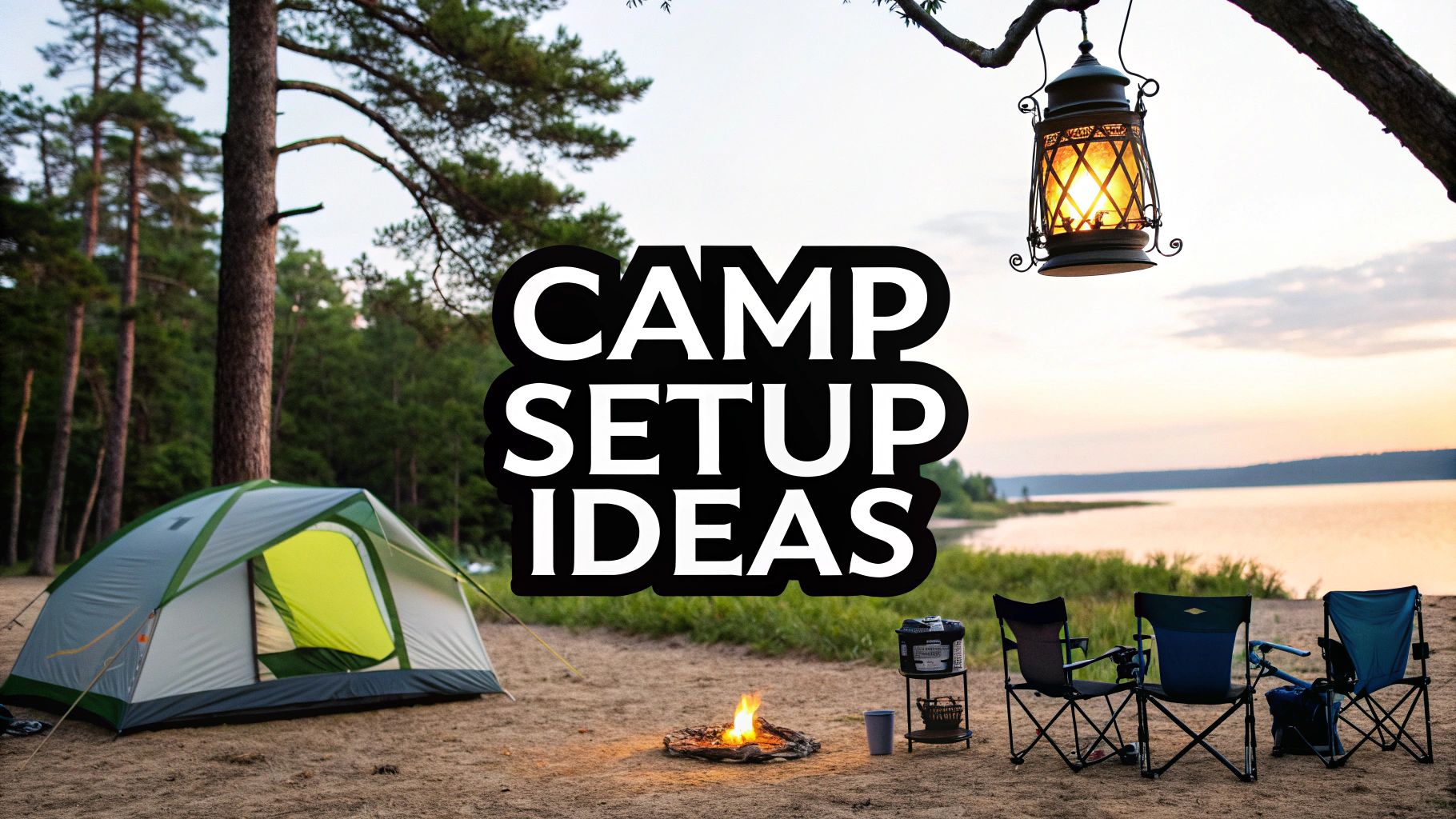
Level Up Your Camping Game
Want exciting new camp setup ideas? This list offers unique approaches to transform your 2025 outdoor adventures. Discover seven innovative camp setup ideas, from circular layouts maximizing social space to off-grid solar power solutions and all-weather tarp configurations. Whether you prioritize budget-friendly essentials, tech-powered convenience, stylish aesthetics, or family-focused functionality, these ideas will elevate your camping experience. Learn how to optimize your campsite organization and create a truly memorable trip.
1. Circular Campsite Layout
When brainstorming camp setup ideas, the circular layout offers a unique approach to maximizing space and fostering a sense of community. This design revolves around a central communal area, typically a fire pit, with tents arranged in a circle facing inward. This creates a natural perimeter for safety and convenience, while also promoting social interaction. This setup is ideal for group camping trips where shared experiences and easy communication are paramount.
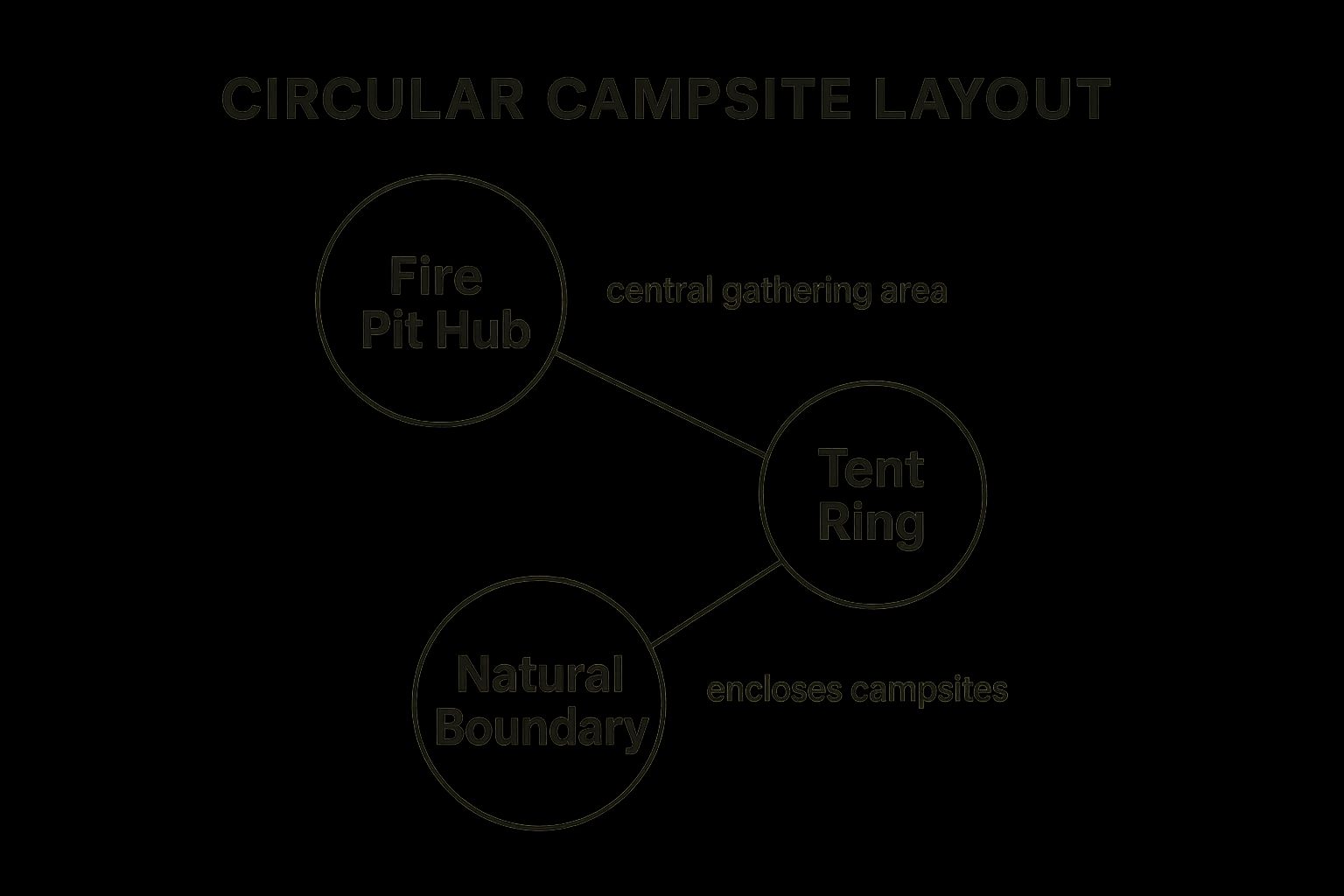
This infographic visualizes the key components of a circular campsite layout. The central concept, the fire pit/communal area, is the heart of the design. Radiating outwards are the tents, positioned to face inwards for a shared experience. Pathways connect the tents to each other and the central area, ensuring easy movement. The outermost ring represents the natural boundary created by the arrangement of tents. The most important relationship highlighted is the focus on community and shared space, facilitated by the inward-facing tents and the centrally located communal area.
The circular layout shines in situations where group bonding is key, such as family reunions, scout troop outings, or even music festival camping circles. Traditional Native American encampments also utilized this layout, demonstrating its historical effectiveness. The inward-facing tents allow for easy communication and shared experiences, while the central fire pit serves as a natural gathering point. This arrangement also provides excellent sight lines, making it easy to monitor children or keep an eye on equipment. If tents are positioned correctly, they can even create a natural wind barrier. In group camping situations, this layout efficiently uses the available space.
However, this layout isn’t without its drawbacks. Privacy is less than in more dispersed setups, and the circular arrangement can be challenging to implement on uneven terrain. It may also not be suitable for very large groups. Additionally, smoke from the central fire can affect all tents equally.
To optimize your circular campsite layout, consider these tips: position tent doors to face the center for convenience and security; place larger tents on the windward side to create a buffer for smaller tents; leave pathways between tents for easy movement; and consider sun patterns when positioning tents to avoid overheating. For a covered communal area within your circular layout, consider incorporating a pergola. Check out these inspiring pergola design ideas to create a shaded and stylish gathering spot. This design consideration adds another layer of comfort and utility to your central gathering space, particularly helpful during inclement weather or intense sun.
The circular camp setup idea deserves a place on this list for its unique focus on community and efficient use of space. It offers a distinct advantage for groups prioritizing shared experiences, offering a practical and sociable approach to camp setup ideas.
2. Elevated Camping Platform
Among the most innovative camp setup ideas is the elevated camping platform. This method involves raising your tent off the ground using a constructed wooden or composite decking platform. This creates a flat, dry, and even surface for your tent, regardless of the terrain beneath. It’s a fantastic way to improve comfort and protect your gear, especially in damp or uneven environments. This approach also minimizes your impact on the natural ground cover, making it a favorite amongst environmentally conscious campers.
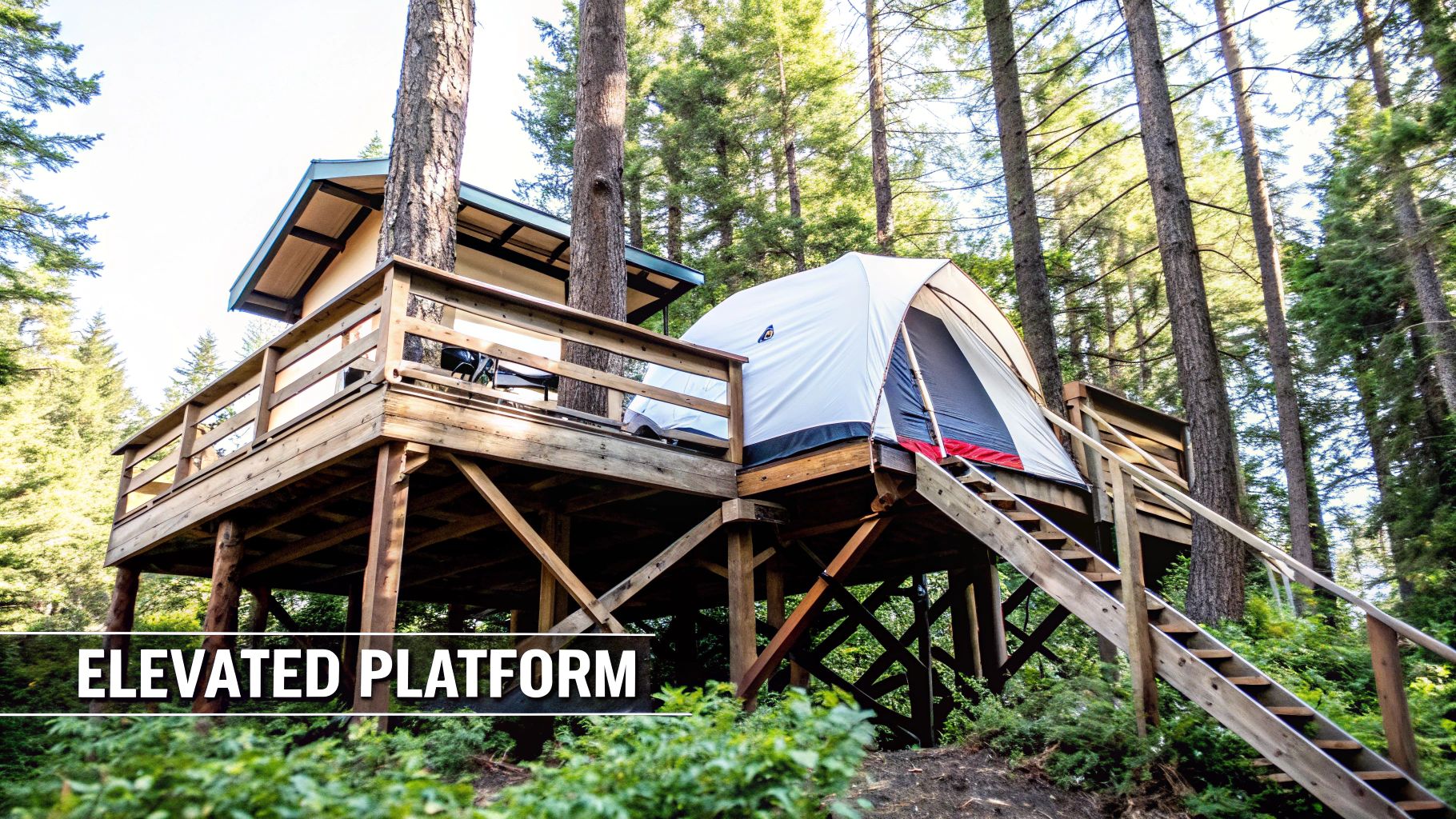
Elevated platforms can be simple or elaborate, depending on your needs and resources. They typically feature a raised frame constructed of wood or composite material, supporting a flat, level surface. Drainage systems, such as strategically placed gaps between planks or a sloped design, prevent water from pooling on the platform. Some platforms even incorporate optional roof structures for added protection from the elements. This camp setup idea deserves its place on the list for its unique blend of comfort, environmental consciousness, and adaptability. Learn more about Elevated Camping Platform for detailed specifications and designs.
Examples of successful elevated platform implementation can be seen in various settings, from the simple tent platforms found in Appalachian Trail shelters to the more elaborate setups used in Pacific Northwest rainforest campsites and eco-lodges in Costa Rica. Even glamping resorts have embraced this concept, incorporating permanent tent platforms for a luxurious outdoor experience.
Pros:
- Dry Gear: Keeps tents and gear dry even in wet conditions.
- Eco-Friendly: Reduces damage to natural ground cover.
- Pest Protection: Provides a barrier against ground-dwelling insects and small animals.
- Clean Living Space: Creates a clean, mud-free living space.
- Ideal for Long-Term Camping: Perfect for extended camping trips or semi-permanent setups.
Cons:
- Construction Effort: Requires significant construction effort and materials.
- Location Restrictions: Limited to locations where building is permitted.
- Portability: Less portable than traditional ground camping.
- Cost: Higher initial cost compared to simple tent camping.
- Permits: May require permits in some areas.
Tips for Building an Elevated Camping Platform:
- Drainage: Incorporate slight elevation differences for water runoff.
- Material Selection: Use naturally rot-resistant woods like cedar or treated lumber.
- Safety: Consider adding side railings for safety, particularly for families with children.
- Wind Resistance: Include anchoring points for securing tents in windy conditions.
- Environmental Impact: Design with minimal environmental impact in mind.
This camp setup idea is particularly well-suited for those seeking a more comfortable and organized camping experience. While the initial setup requires more effort and investment than traditional tent camping, the benefits of a dry, level, and protected sleeping area can be invaluable, especially for long-term campers, families, and those camping in challenging weather conditions. This setup aligns well with the Leave No Trace camping movement and has been adopted by National Park Services in various countries, demonstrating its effectiveness and environmental responsibility. The glamping industry has also played a role in popularizing this approach, showcasing its potential for luxurious outdoor living.
3. Modular Camp Kitchen Setup
A modular camp kitchen setup is a game-changer for organized and efficient cooking in the outdoors. This camp setup idea revolves around dividing your cooking space into distinct zones: food preparation, cooking, cleaning, and storage. Each zone functions independently and can be customized to your specific needs and the nature of your camping trip, making it a highly adaptable system. This approach streamlines meal prep and cleanup, making cooking outdoors a pleasure rather than a chore, which is a major plus for any camping experience. This method deserves a spot on this list because it elevates the entire camp experience, especially for longer trips or larger groups.
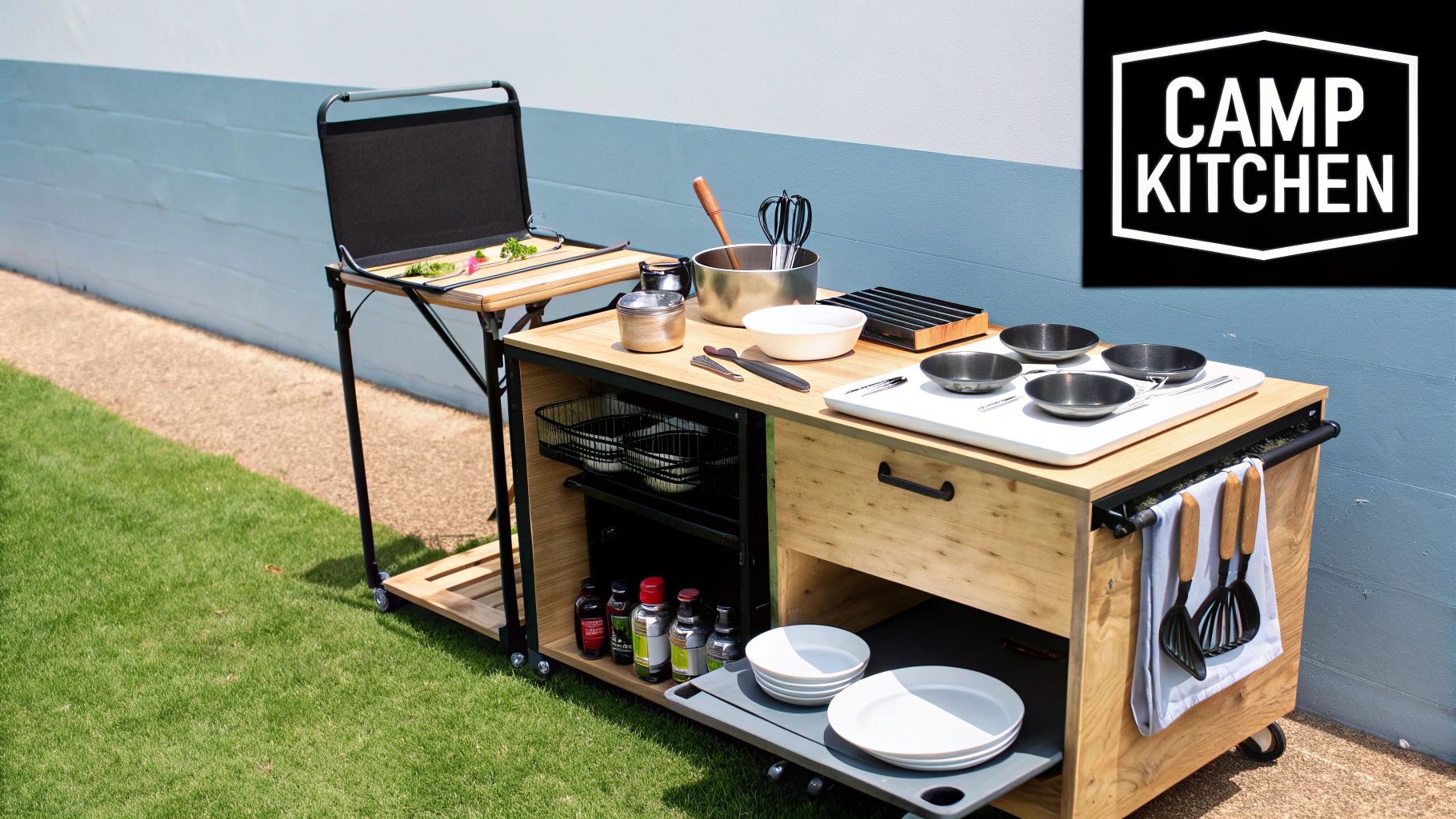
A typical modular camp kitchen includes a portable cooking station with a stove and surfaces at a comfortable working height, a dedicated food prep area with cutting boards and counter space, a water station with storage and potentially a filtration system, organized storage for utensils, spices, and cooking tools, and a designated waste management system. Think of it like building blocks – you choose the modules relevant to your trip. For a weekend getaway, a simple cooking and prep station might suffice. For a longer expedition, you might incorporate all the modules for maximum comfort and efficiency.
Examples of successful modular kitchen setups range from elaborate overland expedition vehicle kitchens to simpler chuck wagon style setups commonly found in modern cowboy camps. Scout jamboree cooking stations also utilize this concept to feed large groups efficiently. Even base camp kitchens for climbing expeditions benefit from the modular organization.
Tips for Implementing a Modular Camp Kitchen:
- Color-coding: Use different colored containers or bins for each zone (food, utensils, cleaning supplies) for easy identification.
- Clear containers: Pack kitchen modules in clear containers so you can quickly see the contents without unpacking everything.
- Strategic placement: Set up the kitchen away from tents to minimize fire risk and smoke issues, but close enough for easy access. Positioning the cooking area downwind from tents is essential.
- Gravity-fed water system: Create a simple gravity-fed water system using elevated water containers for easy handwashing and dishwashing.
Pros:
- Increased efficiency in meal preparation
- Reduced cross-contamination of food
- Dedicated space away from sleeping areas
- Scalable to group size
- Makes cooking enjoyable
Cons:
- Requires more equipment and packing space
- Takes longer to set up and break down
- May be unnecessary for short camping trips
- Needs protection from weather elements
This camp setup idea is particularly beneficial for longer camping trips, larger groups, or when gourmet camp cooking is a priority. While brands like Camp Chef and Coleman offer excellent pre-made components, the overlanding community has pioneered many DIY solutions. YouTube channels like 'Cooking in the Wild' are also excellent resources for modular camp kitchen inspiration and setup ideas. While it requires a bit more planning and packing, a modular camp kitchen significantly improves the overall camping experience by transforming meal times into a more organized and enjoyable part of your adventure.
4. Hammock Village Configuration
Looking for unique camp setup ideas? Ditch the tent and elevate your camping experience with a hammock village configuration. This innovative approach replaces traditional ground-bound tents with a network of suspended hammocks, creating a unique, off-the-ground camping experience that's perfect for the adventurous spirit. This setup is ideal for those seeking a blend of comfort, connection with nature, and efficient use of space, making it a worthwhile addition to our list of camp setup ideas.
This method works by utilizing the vertical space offered by wooded areas. Multiple hammocks are strategically arranged, either in clusters for a communal feel or in lines for a more organized layout. Overhead tarps or rainflies are essential for weather protection, creating a dry haven beneath. A central gathering area can be established beneath or among the hammocks, fostering a sense of community and providing a shared space for meals and conversation. Crucially, tree-friendly suspension systems are used to minimize impact on the forest. Underquilts or other insulation systems provide temperature control, ensuring a comfortable night’s sleep regardless of the weather.
Several examples illustrate the successful implementation of hammock villages. ENO (Eagles Nest Outfitters) often hosts hammock festivals showcasing this style of camping. Appalachian Trail through-hikers frequently utilize hammock clusters for lightweight, low-impact camping. Even in more tropical climates like the Costa Rican rainforest, hammock camps are a popular lodging option. You might also encounter relaxing hammock lounging areas at music festivals.
When and Why to Use a Hammock Village:
This setup excels in wooded environments where flat ground is scarce or uneven. It minimizes impact on the forest floor, making it an environmentally conscious choice. The elevated position offers better air circulation and cooling in hot weather, while also providing protection from ground moisture and crawling insects. Beyond the practical benefits, a hammock village creates a unique camping aesthetic and fosters a strong sense of community.
Tips for Setting Up Your Hammock Village:
- Hang at an Angle: Hang hammocks at a 30-degree angle for optimal comfort and to reduce stress on the trees.
- Protect the Trees: Use wide tree straps (at least 1 inch) to distribute weight and protect tree bark.
- Tarp Placement: Position tarps diagonally to the hammocks for maximum coverage from rain and wind.
- Maximize Space: Create layers of hammocks at different heights if space is limited.
- Stay Warm: Use underquilts rather than sleeping pads for more effective insulation in cooler temperatures.
Pros and Cons:
Pros:
- Eliminates the need for flat ground for sleeping
- Reduced impact on forest floor vegetation
- Better air circulation and cooling in hot weather
- Protection from ground moisture and many crawling insects
- Creates a unique camping experience and aesthetic
Cons:
- Requires adequate trees of appropriate spacing and strength
- Limited privacy compared to tent camping
- Weather vulnerability without proper tarp setup
- Learning curve for comfortable sleep positioning
- Can be cold without proper insulation systems
Brands like ENO (Eagles Nest Outfitters), Hennessy Hammock, Warbonnet Outdoors, and online resources like Shug Emery's hammock camping YouTube tutorials have further popularized this camping style, offering a wealth of information and gear options. While hammock camping might require a small learning curve, the unique experience and numerous benefits make it a compelling alternative to traditional tent camping and a standout among camp setup ideas.
5. Off-Grid Solar Powered Camp
For the eco-conscious camper or those seeking adventure far from civilization, an off-grid solar powered camp setup offers a compelling blend of sustainability and modern convenience. This approach integrates portable solar technology to power essential devices and appliances without relying on noisy, polluting generators or established electrical hookups. Imagine enjoying the peace of the wilderness with the ability to charge your phone, power a laptop, or even run a small fan – all powered by the sun. This camp setup idea is perfect for extended stays in remote locations or simply enjoying a greener camping experience closer to home.
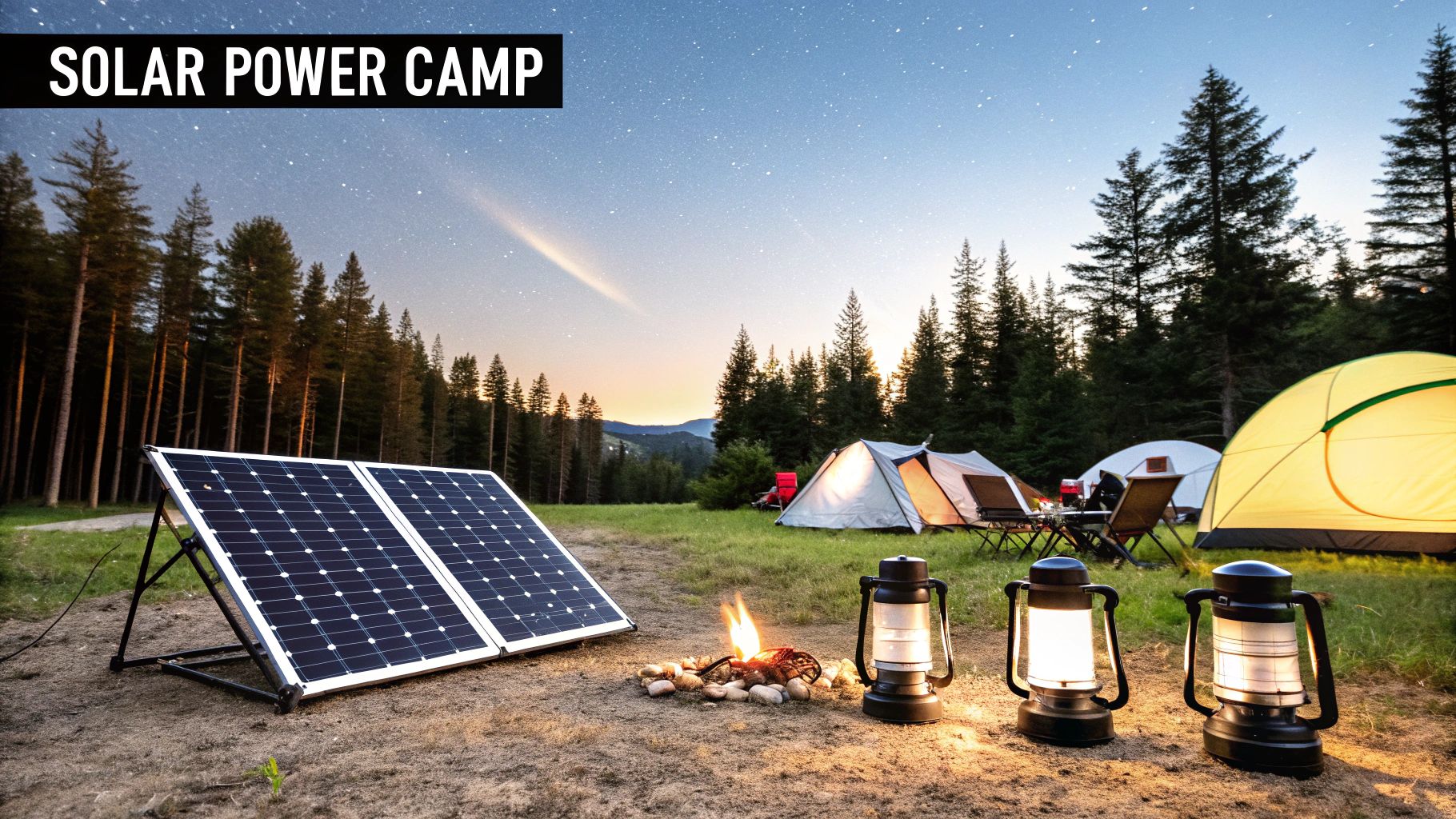
A typical off-grid solar setup includes portable solar panels (foldable or rollable for easy transport), a power storage solution such as a battery or power station, LED lighting systems, USB charging stations, and potentially even energy-efficient appliances specifically designed for DC power. This setup allows you to harness the sun's energy, store it, and then use it to power your devices, creating a self-sufficient camp setup idea. This deserves a spot on this list due to its increasing popularity and ability to enhance the camping experience while minimizing environmental impact. Learn more about Off-Grid Solar Powered Camp
Examples of successful off-grid solar powered camps range from customized vanlife setups adapted for camping, to remote photography and filmmaking basecamps, and even scientific research stations in isolated environments. The elaborate solar arrays seen at events like Burning Man also highlight the scalability and adaptability of this technology.
Pros:
- Silent Operation: Enjoy the tranquility of nature without the roar of a generator.
- Renewable Energy: Reduce your carbon footprint with a clean and sustainable power source.
- Cost Savings: Eliminate fuel costs and the hassle of finding fuel supplies.
- Remote Capability: Extend your adventures to locations far from power grids.
- Modern Convenience: Stay connected and powered up without sacrificing the wilderness experience.
Cons:
- Initial Investment: Solar equipment can be expensive upfront.
- Weather Dependent: Performance relies on sufficient sunlight.
- Power Management: Requires careful monitoring and usage of your power reserves.
- Weight/Bulk: Adds to your overall packing weight and space requirements.
- Backup Power: May need a supplementary power source (like a small generator) for extended cloudy periods.
Tips for Setting Up Your Solar Camp:
- Calculate Power Needs: Determine your total energy consumption to select appropriately sized panels and batteries.
- Panel Placement: Position your solar panels for maximum sun exposure throughout the day, adjusting as needed.
- Energy Efficiency: Use appliances specifically designed for 12V DC systems to optimize power usage.
- Power Management System: Incorporate a power management system or battery monitor to prevent over-discharge and prolong battery life.
- Portable Power Stations: Consider using portable power stations with integrated batteries for a simplified setup.
Brands like Goal Zero, Jackery, EcoFlow, and Renogy are popular choices for portable power systems and solar products. Nomadic solar pioneers like Soulful RV also offer inspiration and practical advice for implementing solar in a mobile setting. This camp setup idea empowers you to embrace sustainable practices while enjoying the comforts of technology in the great outdoors, making it an excellent choice for the modern adventurer.
6. Zoned Campsite Organization
Zoned campsite organization is a highly effective camp setup idea that elevates your outdoor experience from chaotic to comfortable. Instead of a haphazard scattering of tents, gear, and cooking equipment, this method divides your camping area into distinct functional zones, much like rooms in a house. This intentional approach dramatically improves camp flow, enhances safety, and creates a more organized and enjoyable outdoor living space, making it a valuable addition to any camper's repertoire of camp setup ideas.
How it Works:
The core principle is to designate specific areas for different activities:
- Sleeping Zone: A quiet and secluded area for tents, hammocks, or other sleeping arrangements, placed away from noise and cooking odors.
- Cooking/Food Storage Zone: A dedicated space for food preparation, cooking, and storing food supplies. Proper food storage is crucial for minimizing wildlife encounters.
- Communal Zone: A central gathering area for meals, socializing, and relaxation around the campfire.
- Hygiene Zone: A designated area for washing dishes, personal hygiene, and handwashing stations.
- Gear Storage Zone: Keeps equipment organized and easily accessible, preventing clutter and lost items.
- Activity Zones: Designated areas for specific recreational activities, like fishing, games, or a dedicated area for kids to play.
Examples of Successful Implementation:
This method isn't new. Its effectiveness is demonstrably proven by its adoption in various contexts:
- Military Field Camps: Military organizations have long used zoned layouts for efficiency and safety.
- Outward Bound/NOLS: Wilderness education programs emphasize zoned camping for teaching organizational skills and minimizing environmental impact.
- Extended Family Base Camps: For hunting or fishing trips, zones create order and facilitate shared activities.
- Indigenous Camp Designs: Traditional indigenous cultures often utilize zoned layouts, demonstrating the time-tested practicality of this method.
Tips for Creating Your Zoned Campsite:
- Use Natural Boundaries: Leverage existing features like trees, rocks, or fallen logs to define zone boundaries.
- Wind Direction: Position the kitchen downwind from sleeping areas to prevent smoke and food odors from drifting into tents. Consider prevailing winds when choosing toilet locations.
- Clear Pathways: Establish well-defined pathways between zones for safe navigation at night.
- Water Source Protection: Keep washing areas a safe distance from water sources to prevent contamination.
- Color-Coded Gear: Using different colored gear or marking systems for equipment in each zone aids organization and retrieval.
Pros and Cons:
Pros:
- Improved Safety: Separating fire/cooking areas from sleeping areas minimizes fire hazards.
- Wildlife Management: Reducing food odors near sleeping areas decreases the likelihood of attracting animals.
- Efficient Workflow: Designated zones streamline camp activities, saving time and reducing frustration.
- Organized Gear: Makes finding equipment and supplies more intuitive.
- Accommodates Varied Sleep Schedules: Allows members of the group to retire and awaken at different times without disturbing others.
Cons:
- Space Requirements: Requires more total space than a compact camping setup.
- Initial Setup: More complex to plan and set up initially.
- Equipment Needs: May require additional equipment for zone designation (e.g., ropes, tarps).
- Restricted Areas: Can be challenging to implement in small or highly restricted campsites.
Why This Camp Setup Idea Deserves its Place on the List:
Zoned campsite organization represents a significant upgrade to traditional camping methods. While it requires more initial planning and space, the benefits in terms of safety, organization, and overall enjoyment make it a highly valuable camp setup idea for any camping trip, especially for larger groups or longer stays. By implementing this method, you transform your campsite into a well-functioning outdoor living space, maximizing comfort and minimizing the stresses often associated with traditional camping. This structured approach is particularly appealing to families, groups, and anyone seeking a more organized and enjoyable outdoor experience.
7. All-Weather Tarp Configurations
Looking for camp setup ideas that will keep you comfortable no matter the weather? All-weather tarp configurations offer a versatile and adaptable solution for creating protected outdoor living spaces. This approach goes beyond simply pitching a tent, utilizing strategically positioned tarps and shelters to create a comfortable camp in rain, sun, or wind, significantly extending your usable camp area. This method deserves a spot on this list because it offers a high degree of customization and weather protection, potentially increasing your camping season length.
Instead of relying on a single shelter, this method involves using multiple tarps at varying heights and angles, creating a modular system that can be adjusted based on the conditions. Ridge lines and tensioning systems provide stability, while careful water management planning using channels and runoff slopes keeps your living space dry. Wind-resistant deployment techniques are crucial for ensuring your setup can withstand gusts. Think of it as building an outdoor room with a highly adaptable roof and walls.
Examples of Successful Implementation:
- Bushcraft Camps: Interconnected tarp systems provide comprehensive shelter and cooking areas.
- Pacific Northwest Rain Country Camps: Elaborate tarp setups offer crucial rain protection in notoriously wet climates.
- Desert Camping: Shade-optimized configurations create cool, comfortable spaces under the scorching sun.
- Ultralight Backpacking: Minimalist tarp shelters offer lightweight weather protection.
Actionable Tips for Setting Up All-Weather Tarp Configurations:
- Layering: Use a primary high tarp for rain protection and secondary lower tarps for windbreaks and added coverage.
- Water Runoff: Create sloped surfaces (at least 30 degrees) for efficient water runoff. Position tarps to channel water away from your tent and activity areas.
- Adjustability: Use adjustable guylines with tensioners for quick configuration changes as the weather shifts.
- Tarp Variety: Combine square, rectangle, and diamond-shaped tarps for different purposes and optimal coverage.
- Practice Makes Perfect: Practice setting up your tarp system at home before relying on it in the wilderness. This will allow you to familiarize yourself with the process and identify any potential issues.
Pros:
- Comfortable outdoor living space regardless of weather
- Extended usable camp area
- UV protection in sunny conditions
- Increased camping season length
- Lighter and more versatile than many solid shelters
Cons:
- Requires knowledge of proper setup techniques
- Needs multiple anchor points and cordage
- Setup time can be longer than a single tent
- May not withstand extreme weather conditions
- Requires regular adjustment as weather changes
This setup is ideal for camp setup ideas geared towards extended stays, base camps, or situations where weather variability is expected. It's perfect for the travel and outdoor adventurer who values adaptability and comfort. While it may require more initial effort than a simple tent setup, the payoff in terms of comfort and flexibility is substantial. Learn more about All-Weather Tarp Configurations for further details and specific tarp recommendations. Techniques popularized by experts like Ray Mears and brands like Aquaquest, DD Hammocks, Sea to Summit, and Snow Peak highlight the effectiveness and versatility of this approach. Whether you're a budget-conscious shopper looking for a versatile shelter solution or a tech enthusiast interested in optimizing your outdoor experience, all-weather tarp configurations offer a compelling option for your next camping trip.
7 Camp Setup Ideas Comparison
| Idea | Implementation Complexity 🔄 | Resource Requirements ⚡ | Expected Outcomes 📊 | Ideal Use Cases 💡 | Key Advantages ⭐ |
|---|---|---|---|---|---|
| Circular Campsite Layout | Medium – requires terrain and group size consideration | Moderate – tents and central fire setup | Enhanced social bonding; good sightlines; efficient space use | Group camping; family reunions; festivals | Promotes social interaction; natural safety perimeter |
| Elevated Camping Platform | High – construction and possible permits needed | High – materials and tools for building | Dry, flat camping surface; reduced environmental impact | Long-term camps; locations with wet or uneven ground | Keeps gear dry; protects ground; clean camping area |
| Modular Camp Kitchen Setup | Medium to High – more equipment and setup time | Moderate to High – cooking modules and storage | Efficient cooking workflow; food safety; flexible scaling | Expeditions; large groups; base camps | Increases meal prep efficiency; reduces contamination |
| Hammock Village Configuration | Medium – depends on suitable trees and setup skill | Low to Moderate – hammocks, tarps, insulation | Unique camping experience; good airflow; minimal ground impact | Wooded areas; festivals; thru-hiking | Off-ground sleeping; protects vegetation; cool airflow |
| Off-Grid Solar Powered Camp | Medium to High – tech knowledge and system setup | High – solar panels, batteries, electronics | Renewable, silent power source; supports modern devices | Remote camps; long stays; tech-reliant campers | Zero emissions; no fuel needed; sustainable power |
| Zoned Campsite Organization | Medium – requires planning and space | Moderate – gear for zones and markers | Improved safety; efficient camp flow; odor and wildlife control | Large groups; organized base camps | Safety separation; intuitive organization; versatile zones |
| All-Weather Tarp Configurations | Medium to High – setup knowledge and multiple anchor points | Low to Moderate – tarps, cords, and stakes | Weather protection; extended outdoor living space | Rainy, windy, or sunny conditions; bushcraft | Lightweight; versatile; extends camping season |
Ready to Elevate Your Next Camping Trip?
From circular campsite layouts that maximize social space to modular camp kitchen setups that streamline meal prep, this article has explored a variety of camp setup ideas to inspire your next outdoor adventure. We've covered everything from crafting an elevated platform for comfortable sleeping to harnessing the power of the sun with an off-grid solar setup. Remember, the key takeaways are to prioritize organization, comfort, and functionality, whether you're building a hammock village or perfecting your all-weather tarp configuration. Mastering these camp setup ideas will not only make your experience more enjoyable but also allow you to truly connect with nature and create lasting memories. By implementing these strategies, you can transform a simple campsite into a personalized haven, tailored to your specific needs and preferences.
Thinking about putting these camp setup ideas into action? FindTopTrends offers a wide selection of high-quality camping gear to help you build the perfect campsite, from essential equipment to the latest trending products. Visit FindTopTrends today and discover everything you need to equip yourself for any camping scenario.





